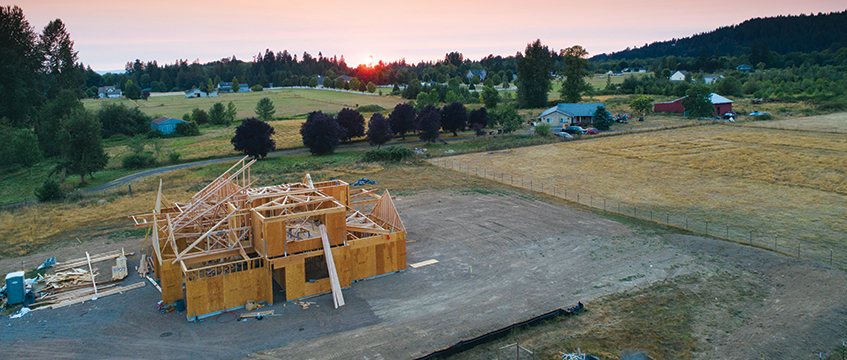Kathryn Hampton and Claire Dutch explore the new National Planning Policy Framework consultation.
As a key part of the government’s levelling up and regeneration crusade, the proposed changes to the National Planning Policy Framework have important consequences for us all. The NPPF sets out how local planning authorities should draft their local plans and must be considered when determining planning applications.
The proposed changes range from greater emphasis on affordable rented homes to draconian measures for developers with slow build-out rates. Here are some of the key proposals:
Housing and the local plan
Despite the light-hearted mockery of some elements of the prospectus (such as the rather bizarre focus on mansard roofs) the wider implications of the changes on housing delivery are no laughing matter. The government is trying to incentivise local plan-making, which it sees as the catalyst for housing delivery, by relaxing some of the requirements. These include:
- removing the requirement to maintain a five-year housing land supply when the local plan is up to date;
- dropping the 5%, 10% and 20% housing supply buffers;
- confirmation that green belt boundaries do not need to be reviewed, even if it is the only way of meeting housing need;
- giving farming for food greater status – the availability of agricultural land used for food production should be considered when allocating sites for development;
- taking past over-delivery of housing into account when assessing housing need;
- not requiring local plans to be “justified” – instead, the inspector will assess whether: (1) the proposed housing target meets need so far as possible; (2) other NPPF policies have been considered; and (3) the plan will be effective and deliverable; and
- an ability to “switch off” the housing delivery test presumption as a consequence of under-delivery, where an authority has granted sufficient deliverable permissions.
The weakening of the “tilted balance” and strengthening of neighbourhood plan policy are also proposed, which may be a concern for developers. The tilted balance in favour of grant of permission is often relied on to secure planning permission for non-allocated sites.
Will it be harder to secure permission on windfall sites? Yes, we think so. Will councils be able to plan for fewer homes than they are currently? They might.
Are we being dense?
Unsurprisingly, there is a strong focus on the development of existing urban areas. The 2020 “urban uplift”, which adds an extra 35% to the housing targets of the 20 largest towns and cities, is retained. New wording stresses that the extra 35% should be met by the towns and cities themselves, not surrounding areas unless voluntarily agreed. The duty to co-operate has been parked and there is still no detail on its replacement, but the “alignment policy” will be consulted on in due course.
Generally, brownfield sites should be prioritised and their density should be optimised. However, proposals must still be mindful of their surroundings, and schemes which include densities that are “significantly out-of-character with the existing area” are unlikely to be approved.
Watch out, developers
Following on from the “bad developer” provisions in the Levelling-up and Regeneration Bill, the government wants to tackle “irresponsible behaviour”. This is not yet defined, but clearly includes breaching planning rules, conditions and obligations. The prospectus asks for views on two options:
- Making bad behaviour a material consideration when determining planning applications (so you are more likely to be refused); and
- Authorities will not have to determine applications submitted by applicants with a poor track record.
They also propose “name and shame” measures where data will be published on developers that fail to build out according to their commitments. No detail is given on whether they will be required to look at the reasons for delay, such as onerous conditions.
Developers will be required to explain how they will maximise a development’s absorption rate to minimise landbanking. The NPPF will make it clear that delivery can be a material consideration in planning applications, possibly leading to refusal of applications with slow rates.
Is there any good news?
There are some positive changes, such as the specific requirement to plan for later living and policy to support the renovation of buildings to improve their energy efficiency. “Beauty” features heavily, and if design codes work could lead to greater certainty and less local resistance.
The consultation also includes questions about the scope of national development management policies, which will set out policies for planning decision-taking. The detail will be included in the later review referred to below.
What’s next?
The government will respond to the consultation by spring 2023, implementing the changes at the same time.
A further, “fuller” review of the NPPF will be conducted “in due course”, once the Levelling-up and Regeneration Bill becomes law. This will look at issues such as infrastructure, climate change and a new financial penalty for slow build-out rates. It will also include the proposed NDMPs, which will be particularly pertinent as they will set how local planning authorities should determine applications, thus shaping future development.
Get involved
The consultation closes on 2 March 2023, so there is plenty of time to comment. We urge you to do so. While not law, the NPPF is one of the most important documents in our planning system, and has rarely been tampered with to such a degree as this. We have the opportunity to shape our country’s future, and we should all be part of it.
View the consultation on the government website >>
Kathryn Hampton is a senior expertise lawyer and Claire Dutch is head of real estate and co-head of planning at Ashurst LLP








